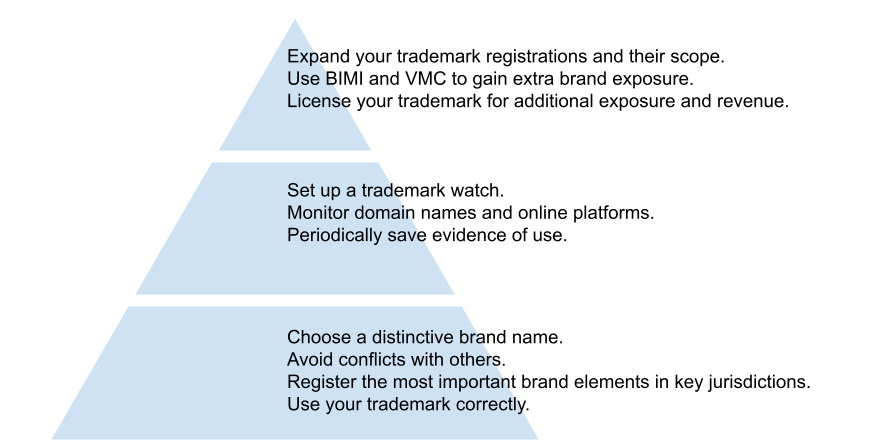Here’s how to build strong trademark protection for your brand. It all starts with a solid foundation.

BASE LAYER – FOUNDATION OF YOUR BRAND
To build strong trademark protection for your brand, it is essential that the foundation is laid correctly. To have a strong foundation for your brand, start with these essentials. If these are not in order, it is not possible to have strong legal protection for your brand.
Choose a distinctive brand name. In order to be legally protectable, a trademark needs to be “distinctive”. A trademark is not distinctive if it describes the product or service in question. For example, SUPERCRUNCH would be a descriptive and non-distinctive name for cookies, as it contains direct information about what the cookies are like. It doesn’t matter in this scenario whether the cookies actually are crunchy or not, the mere fact that the name would be perceived to refer to very crunchy cookies is enough to make it descriptive regardless of the actual characteristics of the cookies sold under that name.
Descriptive names are not perceived as trademarks (names of products), and furthermore, it is important that other companies can give descriptive information about their products. It is important that companies can describe their products (their quality and other characteristics) without being prevented by trademark rights. Giving trademark rights to descriptive names would unduly limit the commercial freedom of those other companies. Exclusive rights can only be given to names that are distinctive.
Avoid conflicts with others. The second foundational building block is having a trademark that can be used without infringing other companies’ trademarks. Before you commit to a brand name, make trademark searches to make sure that nobody else has a prior registration for a similar trademark. If somebody has registered a similar trademark for similar products or services, they may be able to prevent the use and registration of your mark. Needless to say, you cannot build a strong brand for a name you’re not even allowed to use.
Register the most important brand elements in key jurisdictions. Trademark rights are created by registration. You should register at least the name of your product or service. In most cases, you should register your logo as well. These are your most important trademarks.
You should register your trademark in those countries that are relevant to you. Trademarks are territorial, so an EU trademark protects your brand only in the EU. If you manufacture your products in a particular country, you should register your trademark in that country as well.
Use your trademark correctly. Don’t use your trademarks as the descriptive or generic name of your product. Trademarks should be used as adjectives, not nouns. For example, say “iPad tablets” rather than “iPads”. If necessary, follow the trademark with a generic name of the product, such as “Tesla vehicles” (not “Teslas”).
If your trademark is not yet registered, use the (TM) symbol in your marketing material to highlight the fact that the name of your product or service is a trademark. If the mark is already registered, use the (R) symbol.
You should also make sure that others don’t use your trademark as a generic name for the product or service. This is often a challenge for large companies but is also particularly important if you invent a completely new product or service category. For example, when Zumba became popular, there was a real risk that it would be understood to be a particular type of dance rather than a particular commercial origin of the dance. With a lot of effort, they managed to keep Zumba from becoming a synonym for a particular type of dance class. If Zumba was to be understood as a particular type of dance class rather than a brand name, every dance studio could freely offer Zumba (or in that case, zumba) classes.
MIDDLE LAYER – SIMPLE STEPS TO STRENGTHEN THE LEGAL PROTECTION
Once the basics are taken care of, start expanding and strengthening your trademark protection. These extra measures are relatively cheap or in some cases even free to implement, but they play an important role in contributing to the extent and strength of your trademark protection.
Set up a trademark watch. Once your trademark has been registered, make sure that other companies do not use or try to register a similar trademark for the same or similar products and services. Having a trademark watch in place gives you an early warning if others are trying to register a similar name. The earlier you catch an infringing trademark, the better chances you have in trying to prevent it.
Monitor domain names and online platforms. A lot of trademark infringement happens online. You should periodically review important social media and other online platforms to make sure that there is no infringing use of your trademark. Remember that most platforms also provide convenient mechanisms for dealing with infringements.
Periodically save evidence of use. Once the trademark has been registered for five years, it starts being under the “use obligation”. This means that if the trademark is not used for the goods and services covered by the registration, it can be cancelled. To prevent this, you need to be able to prove that you have used your trademark. The easiest way is to periodically save evidence of use.
Such evidence can be printouts from your website, brochures, copies of online and offline advertisements, copies of invoices, and photos from tradeshows and exhibitions. The evidence should show the date and place. For example, printouts from websites should include the date when they were taken. Catalogs and brochures should also show when they were in circulation. If you keep evidence of the use of your trademark, it will be much harder for others to have it cancelled. The fact that you use your trademark is not enough. You must also be able to prove it. You may remember that McDonald’s could not prove the use of their trademark BIG MAC and the EU trademark office cancelled it for non-use.
TOP LAYER – CREAM OF THE CROP
The base and the middle layers already give you good trademark protection. To enhance your protection and brand visibility even further, you can do the following.
Expand your trademark registrations and their scope. Once you have registered your most important trademarks, you should assess if there are any other brand elements you could protect. These might include a slogan (Oatly’s “It’s like milk but made for humans”), a particular colour (like Deutsche Telekom’s magenta), a jingle (McDonald’s “I’m loving it” jingle), a position mark (e.g. Christian Louboutin’s red shoe sole) or a character (Kellogg’s Tony the tiger). Also, constantly review the scope of your existing trademarks. Do they cover all necessary goods and services, and are all relevant territories covered?
Use BIMI and VMC to gain extra brand exposure. Using BIMI (“Brand Indicators for Message Identification”) and VMC (“Verified Mark Certificate”) will allow your registered trademark to be displayed in the inbox of your email recipient. To achieve this you will have to fulfill certain safety and security measures that will make your emails more secure. Having your logo in the recipient’s inbox also increases the opening rate of your email, not to mention giving you extra brand impressions. You can read more about this topic here.
License your trademark for additional exposure and revenue. A great way to expand your brand to new territories (literally and figuratively) is with licensing and co-branding. It is not by coincidence that car companies license their brands to toy companies. Even SMEs can benefit from licensing and co-branding, it is not only for big businesses.



